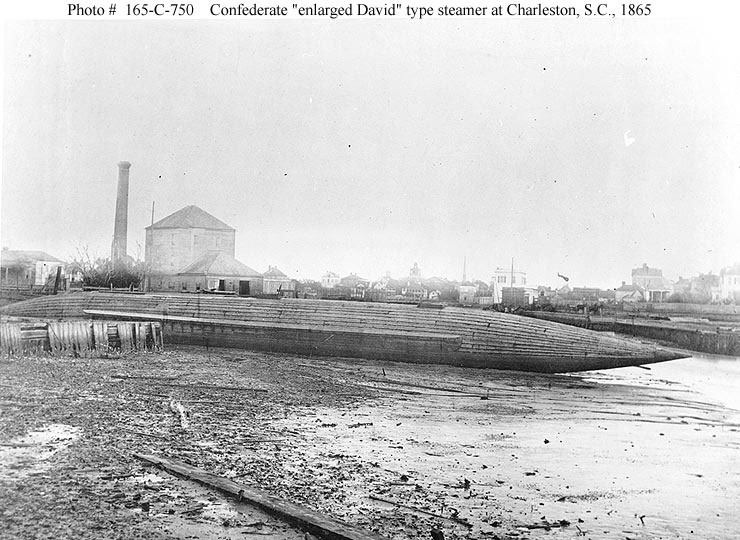Below, photo of grounded David-class ship,
possibly the David herself, after the war.

|
Top, drawing of C.S.S. David, Confederate Torpedo Boat
Below, photo of grounded David-class ship, possibly the David herself, after the war. |
 |
|
The mysterious "Large" David after the war
|
The Hunley was not the only vessel of exotic design intended to attack the Union blockade fleet. The "Davids" were Confederate steam-powered torpedo boats, designed by David Chenoweth Ebaugh.. The first, the David, apparently got her name from the bible story of David and Goliath -- with the U.S. Navy blockade fleet in the role of Goliath. The cigar-shaped David looked like a modern submarine with a smokestack attached, but she was a surface ship, with an open cockpit. Designed to operate semi-submerged so as to provide as small a target as possible, the David was to attack under cover of darkness by ramming a barbed spar with a "torpedo" or bomb on it into the side of an enemy ship, then escaping. It was much the same attack plan used by the Hunley. The CSS David attacked and damaged the ironclad USS New Ironsides on October 5, 1863, but was swamped by the explosion of her own torpedo and barely escaped herself.
Several other David-class vessels were built, but it is unclear how many, and there are only sketchy records of their operation. There do not seem to have been any other even partially successful attacks. It is possible that the David or one of her sisters served as a tender for the Hunley, towing the hand-cranked sub during some training exercises, or even out on the first leg of attack runs, so as to conserve the crew's strength. The two vessels were of similar size, and used the same weapon -- a spar torpedo rammed into the enemy ship.
There are photographs of what appears to be a "large" David, three times longer than the original. It was apparently intended as an advanced blockade runner, but it was captured, incomplete, at the end of the war. There are a number of images of the David toward the bottom of the page at http://www.charlestonillustrated.com/hunley/gallery.htm. There are images of David and the Large David at: http://www.ibiblio.org/hyperwar/OnlineLibrary/photos/sh-us-cs/csa-sh/csash-hl/lg-david.htm. (This is a page of a privately owned website that duplicates the previous version of the Navy's History website. See the bibliography page of this website for further discussion.) See also the website http://www.charlestonillustrated.com/hunley/david.htm..
Visit www.vernianera.com/CigarBoats.html to read about and view images of the Winans Cigar Ships -- vessels just as strange, intriguing and unsucessful as the David and the Hunley, but built in the North by Ross Winans and his son Thomas.
As with the U.S.S. ("United States Ship" prefix used by the U.S. Navy, the prefix C.S.S. is properly used only for ships commissioned into the Confederate States Navy. Some books call the sub the C.S.S. Hunley, but, although the H. L. Hunley fought for the Confederates, she was privately built and was never actually commissioned into the C.S. Navy. By some accounts, she was actually controlled by the Confederate Army. The initial H. L. refer to the first and middle name of Mr. Horace Lawson Hunley, one of the boat's designers, who also financed much of the work. Furthermore, the Hunley should more properly be called a boat, not a ship. In naval terms, a boat is defined as being a water vessel small enough to be carried aboard a larger vessel -- a ship. (Another definition is that a boat is a vessel that is routinely removed from the water.) Submarines -- even modern day monster-sized nuclear-submarines as long as the Washington Monument is tall -- are also called boats, even though they don't follow the definition . Probably this is because the first subs were in fact small enough to be carried by a ship. Or it might just be because submariners wanted a word that made it clear their craft were different from all other naval vessels. (Even so, American submarines use the prefix U.S.S. -- not U.S.B.!)
See this link to the section on the Hunley in our updates and corrections page. Scroll down the page for more information on the fates of her three crews.
See also vernianera.com/Hunley/index.html for a complex recontruction of the Hunley, and hunley.org for a fully detailed account of the boat, her loss, her recovery, and the effort made to preserve her. This link to the U.S. Navy History and Heritage Command provides access to multiple U.S. Navy articles and images concerning the Hunley.
The errata and updates pagee for Mr. Lincoln's High Tech War has more information about how the Hunley was named, and about the men who died aboard her.